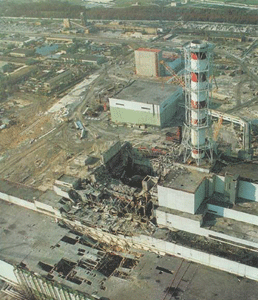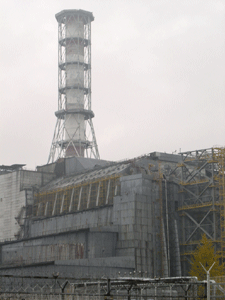Sealing the Sarcaphagus
Air Date: Week of May 2, 2008

The aftermath of the 1986 nuclear disaster.
More than twenty years after the Chernobyl explosion, Host Bruce Gellerman looks at plans to entomb the crumbling sarcophagus over the nuclear reactor in the Ukraine.
Transcript
GELLERMAN: Now an update to a story I first reported in 1996, on the tenth anniversary of Chernobyl, a place synonymous with nuclear disaster.
[MAN SPEAKING RUSSIAN; SOUND OF ENGINE RUNNING]
GELLERMAN: On April 26,1986, Chernobyl reactor number four at the Soviet atomic power plant in Ukraine erupted into a nuclear volcano, spewing radiation around the world.
[FOOTSTEPS, SPRINGS CREAKING]
GELLERMAN: We’re standing at ground zero. Today what remains of the melted number four reactor is entombed in a massive 24-story sarcophagus. But even 300,000 tons of steel and concrete can’t contain the intense radiation within.
[MAN SPEAKING RUSSIAN]
TRANSLATION VOICEOVER: Four point five millirems per hour.
GELLERMAN: Today, almost exactly 22 years after the world’s worst nuclear accident, the Chernobyl power plant, with its hastily constructed sarcophagus entombing the doomed reactor, is still one of the most radioactive places on the planet.
Now finally, after years of delays, there are plans – and one and a half billion dollars – to deal with the contaminated site. Half a billion will go to a French construction company to build an enormous confinement shelter, says Ken Brockman, Senior Safety Consultant with the World Nuclear Association.
BROCKMAN: You need to realize it’s very massive. We’re talking something here that will totally cover the entire building that was there: three to four football fields long, two football fields wide and a football field high. Picture one of the large domes that people play tennis under; that’s sort of the shape.

The 'sarcophagus,' the temporary shell that was placed over the structure to contain radiation, is now becoming unstable. (Photo: David Thair)
BROCKMAN: There will be a point in time with that structure you will say, we need to do something additional to it. I’m very confident that the technology of the future will have some capabilities to be able to supplement this or even replace it in a way that we can’t even fathom today. But, if you don’t even accept that, you could take the technology of today. You could build a little bit bigger arch, one that’ll handle two Statues of Liberty, and put that right over the top of it.
GELLERMAN: You know, in Russian they called it a motroshka doll – that’s the nesting dolls, see one goes in on top of the other.
BROCKMAN: I never thought of it in that way, but you know the matroshka would certainly be a philosophy that could be used, and it’s probably a very good one because if you’ve ever seen these nested doll sets, each one is perfectly maintained inside the other.
GELLERMAN: It’s estimated 95 percent of the nuclear fuel – 200 tons of radioactive material – still remains buried within the sarcophagus. Some of the radioactive elements have a half-life of several thousand years. It took 800,000 Soviet soldiers and workers to construct what was supposed to be a temporary tomb.
Jim Riccio, nuclear policy analyst for Greenpeace, agrees that a new shelter to prevent another disaster is critical, but says we have yet to learn the real lesson of Chernobyl.

The aftermath of the 1986 nuclear disaster.
GELLERMAN: Once, 120 thousand people lived within 30 kilometers – about 20 miles – from the Chernobyl power plant. They were evacuated after the disaster and have been prohibited from moving back. Ever since, it’s been a landscape of ghosts – abandoned schools and homes, a huge rusting Ferris wheel. And Philip Metcalf, from the Division of Radiation Transport and Waste Safety at the International Atomic Energy Agency says, it’s likely to remain that way for many, many years.
METCALF: Within, you know, probably five to ten kilometers – that’s an area that’s probably going to have to be sort of sanitized for the next two or three hundred years.
GELLERMAN: Plans haven’t been finalized yet, but Metcalf says the remains of the doomed reactor will most likely be buried in the area around Chernobyl.
METCALF: The idea will be to dismantle the existing structure, the so-called sarcophagus, dismantle that, remove it, and then remove the radioactive residues from the damaged reactor core. So probably within the next sort of fifty years, that work will take place, and hopefully fifty, sixty years hence, there will be nothing left and the actual – the new construction can then be dismantled.
GELLERMAN: Construction of the Chernobyl New Safe Confinement Structure is scheduled to begin late this fall.
Links
Living on Earth wants to hear from you!
Living on Earth
62 Calef Highway, Suite 212
Lee, NH 03861
Telephone: 617-287-4121
E-mail: comments@loe.org
Newsletter [Click here]
Donate to Living on Earth!
Living on Earth is an independent media program and relies entirely on contributions from listeners and institutions supporting public service. Please donate now to preserve an independent environmental voice.
NewsletterLiving on Earth offers a weekly delivery of the show's rundown to your mailbox. Sign up for our newsletter today!
 Sailors For The Sea: Be the change you want to sea.
Sailors For The Sea: Be the change you want to sea.
 The Grantham Foundation for the Protection of the Environment: Committed to protecting and improving the health of the global environment.
The Grantham Foundation for the Protection of the Environment: Committed to protecting and improving the health of the global environment.
 Contribute to Living on Earth and receive, as our gift to you, an archival print of one of Mark Seth Lender's extraordinary wildlife photographs. Follow the link to see Mark's current collection of photographs.
Contribute to Living on Earth and receive, as our gift to you, an archival print of one of Mark Seth Lender's extraordinary wildlife photographs. Follow the link to see Mark's current collection of photographs.
 Buy a signed copy of Mark Seth Lender's book Smeagull the Seagull & support Living on Earth
Buy a signed copy of Mark Seth Lender's book Smeagull the Seagull & support Living on Earth

